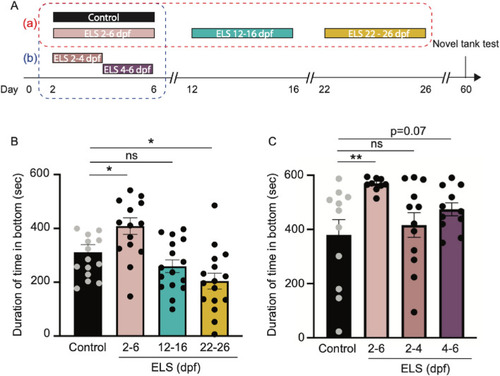
Chronic stress in a time window between 4 and 6 dpf is critical to impact behavior later in life. (A) Timeline of ELS paradigm and novel tank test. Different groups of larvae were subjected to ELS at different ages. In group (a) (red box), larvae were placed in ELS paradigm at 2–6, 12–16, or 22–26 dpf, alongside same aged and unshocked controls. In group (b) (blue box), larvae were placed in the paradigm at 2–6, 2–4, or 4–6 dpf, while control siblings remained alongside in the incubator throughout the 5 days. (B) Quantification of duration spent in the bottom zone of the novel tank test at 60 dpf suggest that only chronic stress during the 2–6 dpf period caused increased bottomdwelling behavior, and not at later times. Multiple unpaired t-tests were performed between control and ELS siblings at three time windows. Control vs. ELS 2–6 dpf : p = 0.014; Control vs. ELS 12–16 dpf: p = 0.081; Control vs. ELS 22–26 dpf : p = 0.0066. (C) Quantification of durations spent in the bottom zone of the novel tank suggest that stress between 4 and 6 dpf may be sufficient to cause increased bottom-dwelling behavior later in life. Statistical analysis done using multiple unpaired t-tests were performed between control and ELS siblings at three time windows. Control vs. ELS 2–6 dpf: p = 0.0026; Control vs. ELS 2–4 dpf: p = 0.31; Control vs. ELS 4–6 dpf: p = 0.07. Controls: n = 11; ELS 2–6 dpf: n = 10; ELS 2–4 dpf: n = 12; ELS 4–6 dpf: n = 11. Error bars show ± standard error of the mean. Asterisks denote statistical significance (***p = 0.0005, **p = 0.005, *p = 0.05).
|

